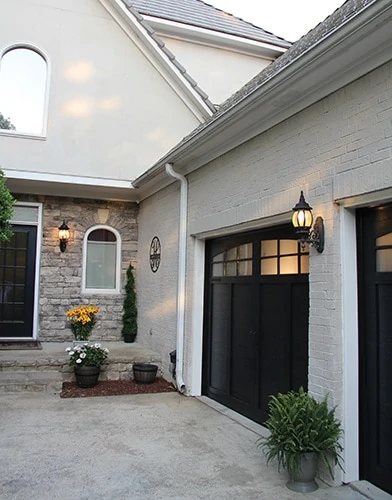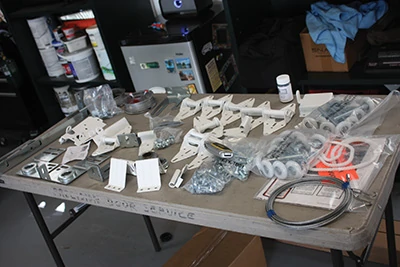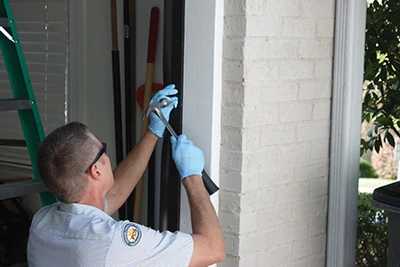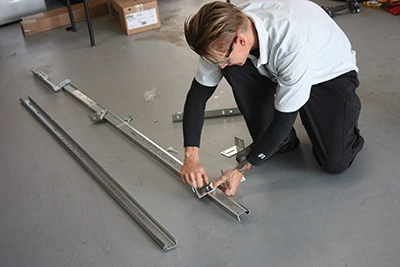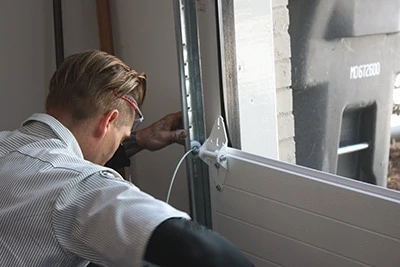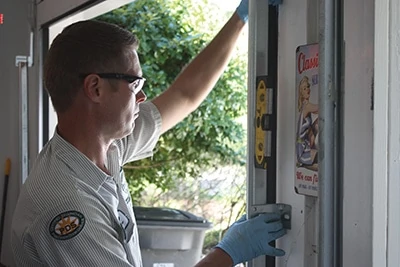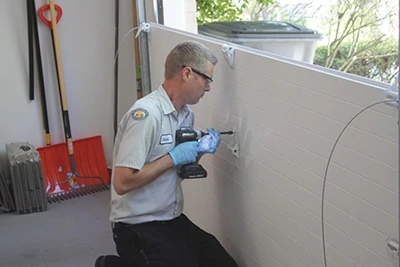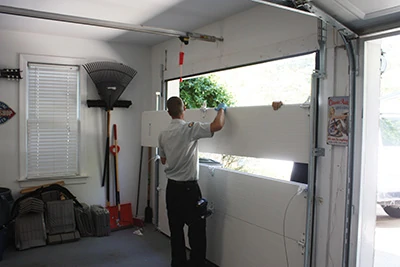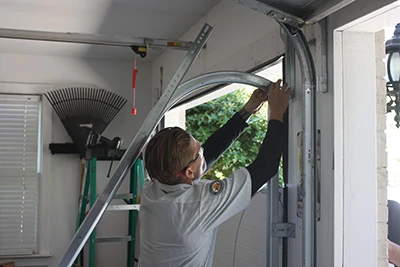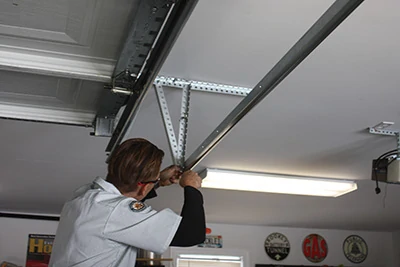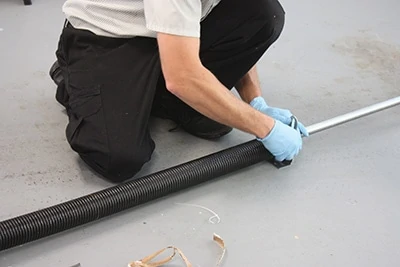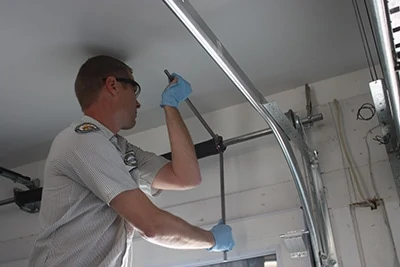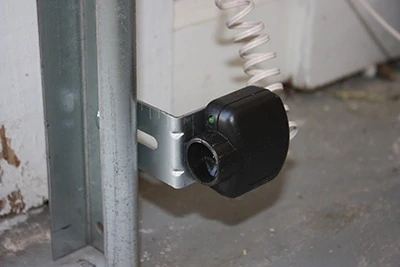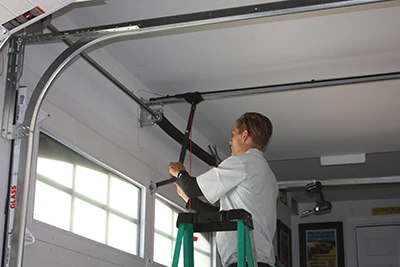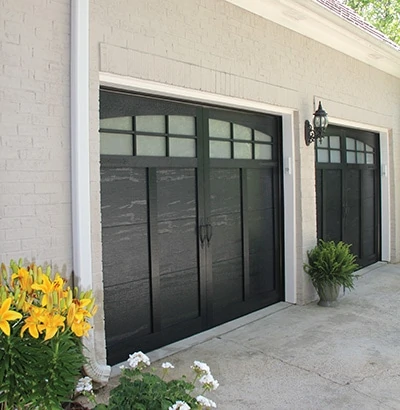The two large garage doors at the front of the house accounted for a great deal of its exterior decor. To give the house a fresh boost of curb appeal, the homeowner upgraded the two aluminum overhead doors with a couple of handsome new insulated units from the American Tradition Series by Haas Door Company. The new doors not only add to the look of the home, but they offer better weather protection, increased energy savings, smooth, quiet operation and a perfect fit. Here’s how the professional installers at Precision Overhead Door Service got the job done.
Selection
Overhead door designs have come a long way, and an insulated door is the way to go for the sake of your energy bills. Even if you don’t spend much time in your basement, a thin uninsulated door offers little cold-weather protection, and a cold garage will transfer those cool temperatures into the house if it’s connected. Is your water heater in the garage? That’s an often-overlooked appliance that doesn’t have to work as hard if the heater is located in an insulated environment. The American Tradition Series of garage doors contains CFC-free polyurethane insulation with R-value of 13.45.
The available styles in garage doors have also evolved over the years. These days homeowners can choose from a wide range of panel and trim designs, a broad variety of window configurations, as well as various glass options. You can select from a rainbow of colors, choose your favorite door finish, and give it a personal touch with optional accessories such as faux door hinges and handles to give the illusion of vertical double doors.
The Haas American Tradition Series shown in this article translates the beauty of a wooden carriage-house door into a woodgrain-embossed steel surface that provides a stronger barrier to the elements than actual wood.
Notably, Haas has a handy online tool at www.haascreate.com where homeowners can upload a photo of their home and then digitally “create” a door design from the site’s array of design options. The app provides a visual representation of how your style of choice will look on your house. You can also contact a customer service representative for help with selection.
Spring Options
Any professional door installer is going to recommend torsion springs over extension springs. A torsion spring is usually mounted to the wall along the top of the closed door. Extensions springs are intended to work in tandem at the sides of the door and are mounted parallel to the ceiling tracks. Whereas extension springs fully expand and contract when operating an overhead door, the torsion springs turn. Torsion springs may cost more but they’re a better investment because they last much longer—15,000 to 20,000 cycles compared to 10,000 cycles with extension springs.
Plus, torsion springs perform much better. Torsion springs operate with a controlled, steady motion as the garage door opens and closes, which keeps your door in proper balance. Extension springs can result in that rambling, noisy, jerking motion that you’ve probably encountered at some point in life. And, although they might provide a lot of tension when you first open the door, once the tension releases, the door can travel up much faster, and all the jerky imbalance from the springs can cause your door to misalign, leading to wear and damage to other parts of the system.
Although torsion springs are the preferred choice for a new garage door, installing them can be very dangerous for anyone who isn’t properly trained and experienced. Torsion springs are under extreme tension, and installing them requires solid steel winding bars (which most of us don’t have in our toolbox). In fact, the Haas operation and maintenance manual warns that people who attempt to work on a torsion spring assembly “without proper training or tools may result in an uncontrolled release of spring forces, which can cause serious or fatal injury.” For this reason, the EHT staff suggests you leave this type of garage door installation to the professionals. A pro installer will also be familiar with how to assemble the various components of the complicated track-and-motor system, which ensures that your new door is a smooth operator.
Teamwork
A new garage door system has a lot going on, from the electric garage opener and the slotted angles (which support everything from the ceiling) to the tracks, springs, wire, trim and door panels. The team at Precision Overhead Door Service divided the work between themselves for a multi-pronged attack that knocked out the project in short order, whereas a would-be DIY’er would probably be left scratching their head for days.
The installers first inventoried all the various components and confirmed that the door measured appropriately for the opening. The next step involved one worker preassembling some of the track components while another worker installed trim along the door jamb. Working in tandem, the team had both doors successfully installed in just a few hours.
Here’s an overview of the steps involved.
Step by Step
First step is to unpack and inventory the components.
The installers divided the work, with one installing the trim that will seal the air gap surrounding the door.
Another worker preassembled the door tracks that will mount to the wall.
The garage doors are assembled one panel at a time, working from the ground up. A perfectly level installation is critical for proper door operation. (No shims were required here.)
Each panel is fitted with hinges and roller brackets.
The vinyl rollers slip into the roller brackets to give the door smooth travel along the tracks.
With the rollers in place on the lower door panels, the door tracks are then positioned around the rollers.
Make sure the tracks are perfectly plumb for proper door operation.
The tracks must be mounted securely to the wall. Note the wood shim behind the bracket, which keeps the mounting surface in a solid, even plane.
The door panels are attached to each other with a strong center hinge.
Panel by panel, the workers assemble the door.
The ceiling tracks are curved to fold the door panels as they rise.
The ceiling tracks are suspended by slotted angle brackets mounted to the ceiling. The workers were able to reuse the existing angle supports left from the old garage door.
Torsion springs operate with a controlled, steady motion as the garage door opens and closes.
The torsion springs are mounted above the door on a center bracket.
Winding the torsion spring requires using 18-in. winding bars made from 1/2-in. diameter cold rolled steel (which is not a typical toolbox staple).
Drums at each end of the torsion-spring bar hold the cables that help lift the heavy door.
The top panel of this door includes the window design.
The door-opener is installed along the center of the opening and is wired to sensors at the bottom of the door. The motor plugs into a receptacle at the ceiling.
The laser-triggered safety sensors raise the door if they detect an obstruction in the doorway.
An electronic keypad mounted on the outside of the garage can open the door using a security code.
The opener’s lifting bracket is attached to the mounting plate, and the new garage door is ready for testing.
Shown here are the new doors after installation.
Side Note 1
PDS800 Newton DC-Powered Garage Door Operator



